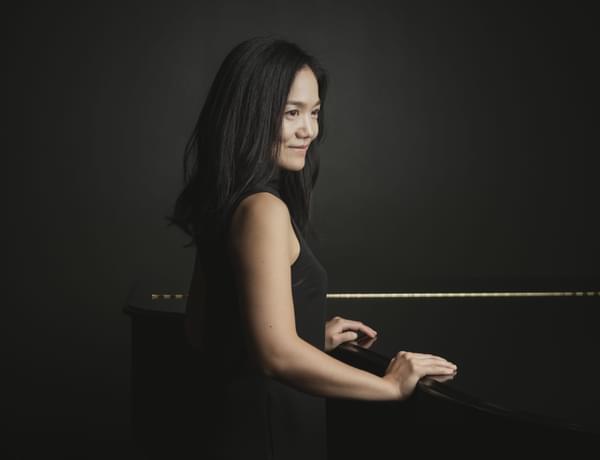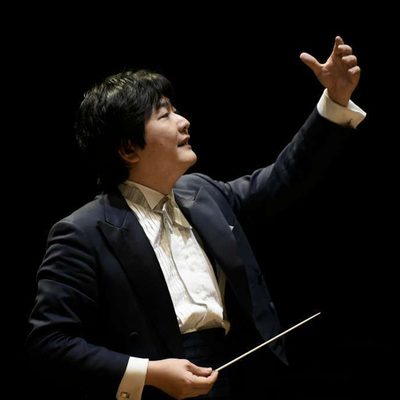Kazuki conducts Rachmaninoff & Tchaikovsky

Full programme
- Rachmaninoff, Piano Concerto No.2 (32mins)
- Tchaikovsky, Symphony No.5 (47mins)
Performers

Kazuki Yamada
Conductor
Hisako Kawamura
Piano
Introduction
I am really looking forward to this concert. I love playing with both Kazuki and the CBSO. Kazuki is both a great musician and a great human and I can guarantee we will have a fun time together!
This will be my fourth performance with the orchestra and it will be great to catchup with the friends I have made over the years.
I am thrilled to be returning this year to play Rachmaninoff’s Second Piano Concerto both in Birmingham and on the Japan Tour.
This piece is a milestone concerto for me. I refused to play Rachmaninoff for many years because I favoured more classic composers like Beethoven, Schumann and Mozart. I was a little dumbfounded by the sheer number of notes and the thick, vast sounds in Rachmaninoff’s music. So, by the time I started to play his works, I was in my late twenties. I performed and recorded the second concerto with Czech Philharmonic in 2014 – the performance made me remark that Rachmaninoff is actually such a great composer and prompted me to play many works by him, not only piano but chamber works too.
I really enjoy Rachmaninoff’s music; it is very touching and really hits us directly in our soul. His melody and harmony is so eccentric yet incredibly emotional. This concerto in particular was written as a form of self-therapy after a disastrous first performance of his first symphony, causing him to quit composing for over a year. During this time he saw a therapist, Dr Dahl, who helped him return to composing and within this time he wrote his second piano concerto.
There’s a very dark mood in the first movement with very complex harmonies and structure – although it has beautiful melodies, it has a real sense of overcoming pain and healing the wound. The second movement again has a very sweet melody but during the middle it visits very complex phrases that never truly resolve and conclude. We do come to a happy end in the third movement and we are able to feel that Rachmaninoff has finally healed and can compose once again!
It's such a powerful concerto and I’m not only looking forward to playing it in Birmingham but also in my home country, Japan.
Hisako Kawamura
Piano
Programme notes
From those thrilling opening chords to the stormy last bars Rachmaninoff’s second Piano Concerto is peak Romance, and Hisako Kawamura brings out the surging power of the solo role. Kazuki and the CBSO partner in Tchaikovsky’s symphonic journey from despair to triumph.
Piano Concerto no.2
Sergei Rachmaninoff (1873-1943)
The 1946 film Brief Encounter begins with a train roaring out of the fictional Carnforth station. Its thunderous noise obscures the initial opening notes of the film soundtrack; the dramatic start of Rachmaninoff’s second Piano Concerto, with its spread chords and turbulent melody, emerges from the cacophony. Right from the start, the film conveys a sense of urgency, and of surging passion. It was Noël Coward’s idea to use the Rachmaninoff this way – he wrote the screenplay – and Coward’s biographer Oliver Soden notes that the Concerto gives this British, suburban tale of thwarted love a thrill of Russian melodrama. (Another film, The Seven Year-Itch starring Marilyn Monroe, has the deluded hero attempting to seduce Monroe with the same piece; she prefers Chopsticks). All of which preamble is to set the scene for a work which – while some might consider it a cliché – still has an extraordinary power in performance.
This power is partly conveyed through the magical way Rachmaninoff writes for piano; a brilliant performer, he was the soloist at the premiere in 1901. But it is mostly expressed through its seemingly endless supply of soulful melodies, creating an atmosphere of perpetual yearning. The opening theme, for example, lasts an initial eight bars, but then expands into a continuous sequence, eventually lasting some forty-four bars. After a fanfare-like flurry, a new, equally gorgeous theme begins in the piano. And so it continues. The second movement starts with yet another rapturously seamless tune (years later it was to become the basis of Eric Carmen’s rock ballad ‘All by myself’, made famous in yet another film: Bridget Jones’ Diary). It comprises a dreamy series of triplets, and is deliberately off-kilter with the orchestral theme above. The final movement, mostly in a more jaunty spirit, has another show-stopper as its second major theme.
The Concerto’s melodies are generously shared between orchestra and piano, the soloist often duetting with a member of the woodwind, and for such a virtuosic work for piano, there is surprisingly no lengthy ‘cadenza’ for solo piano. Instead, there are brief sections of fireworks in each movement before the main business of this work – melody – is reclaimed. The Concerto ends in a well-earned major key, all passion finally spent.
Symphony no.5
Pyotr Ilyich Tchaikovsky (1840-1893)
Tchaikovsky was a prolific composer, possessed of a mercurial, turbulent character and often a powerful sense of self-doubt. His life was punctuated by dramatic relationships, such as his short-lived marriage. But in the summer of 1888 he was in tentatively good spirits, embarking on his fifth symphony while on holiday in Frolovskoe, not far from Moscow. Despite having worried to his brother Modest that his talent was drying up, he wrote shortly afterwards to patron Nadezhda von Meck ‘I cannot tell you what a pleasure it has been to watch my flowers grow and see daily – even hourly – new blossoms coming out….I have been working with good results, for half the symphony is now orchestrated.’
The symphony continued to bloom and grow, forming its structure and atmosphere around a dominant motif first heard at the start, then making appearances throughout. Tchaikovsky noted that the symphony’s ‘programme’ suggested ‘Complete resignation before Fate, or…the inscrutable predestination of Providence,’ and the opening theme is frequently described as the ‘fate’ motif. The symphony is abundantly rich in other melodies, with four significant themes in the first movement alone, ranging from jaunty to yearning. Yet most of them bear at least some resemblance to the fate motif, either through a dotted, stuttering rhythm or a downward slope of melody. The opening movement ends not with a bang, but with an ominous, whispered descent into the depths of the orchestra.
The second movement begins with one of the most famous themes in the orchestral repertoire, initially on the solo horn (any resemblance to the famous ‘Annie’s Song,’ is – according to John Denver – entirely accidental). A clarinet joins in with a soulful counter-melody, followed by an oboe determined to cheer things up with a new melody. These themes, along with a pulsing underpinning from the rest of the orchestra, lead Tchaikovsky towards the romantic territory of his Romeo and Juliet overture composed some eight years earlier. The ‘fate’ motif dramatically intrudes into atmosphere twice during the movement, the first time seeming to send the orchestra into shock before it regathers with the opening theme. The delicate, dance-like third movement borrows its melody from an Italian street-song, and the ‘fate’ motif takes more or less a back seat. Yet it is strongly to the fore in the finale, where it eventually transforms into a major key. For some, this is a ‘triumph’ over fate, the trumpets blasting heroically over the ensemble. Yet Tchaikovsky was not especially happy with the conclusion, writing that it had ‘a certain excess of gaudiness and insincerity.’ Yet, perhaps with ears attuned to ironic overstatement (such as at the end of Shostakovich’s Fifth Symphony some years later), we might feel those final E major chords have a darkly sinister rather than ‘gaudy’ edge.
© Lucy Walker
Featured image © Marco Borggreve